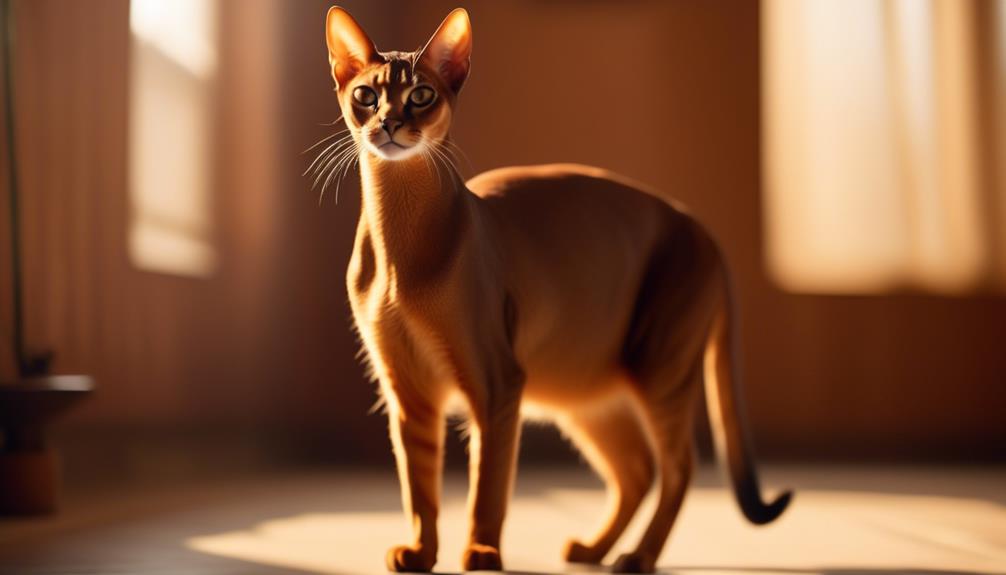
Thanks to its mysterious origins and stunning appearance, the Abyssinian cat breed has long been a subject of fascination among cat lovers.
The Abyssinian is a captivating breed with its short, ticked coat and unique color patterns.
But there is much more to this enigmatic feline than meets the eye.
This discussion will uncover the secrets behind the Abyssinian’s historical significance and explore its intriguing temperament and exercise needs.
We will also delve into the essential care practices that ensure the well-being of these remarkable cats.
Prepare to be captivated by the world of Abyssinian cat breed information and characteristics.
Key Takeaways
- The Abyssinian breed originated near the coast of the Indian Ocean and Southeast Asia and has a diverse genetic makeup.
- Abyssinians have a short, ticked coat with various colors and tabby markings.
- The breed’s mysterious origins and captivating characteristics add to its historical importance and allure.
- Prioritize adoption from reputable shelters or rescue organizations and research the ethical practices of breeders if choosing that route.
Origin and Size
The Abyssinian cat breed, believed to have originated near the coast of the Indian Ocean and Southeast Asia, is a medium-sized feline weighing 6 to 10 pounds.
This natural breed has a rich history, with the first mention of Abyssinians occurring in the Crystal Palace Cat Show in 1871. Unfortunately, there are no records regarding their exact origins.
However, genetic evidence suggests that these cats may have come from Indian Ocean coastal regions and Southeast Asia, possibly brought by British and Dutch traders.
Supporting this theory is a specimen exhibited in the 1830s, which aligns with the idea of an Indian Ocean origin.
Despite their mysterious beginnings, Abyssinians make wonderful pets with their playful, affectionate, and intelligent temperament. They have high exercise needs, are trainable, and require low-maintenance grooming.
However, they are prone to certain health conditions, such as progressive retinal atrophy and amyloidosis.
See Another Cat Breed Profile
York Chocolate
Breed Group and Lifespan
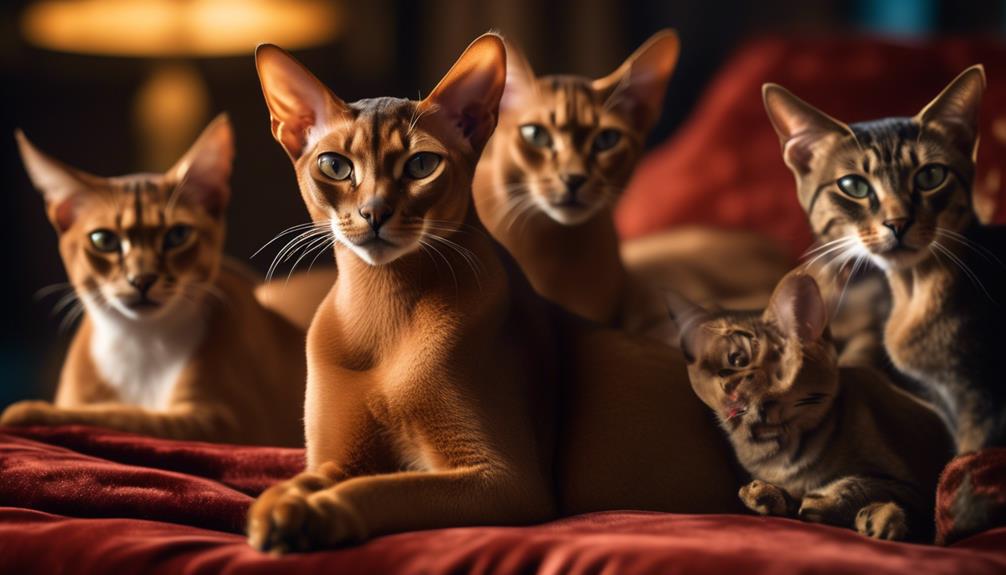
Abyssinians belong to the natural breed group and have an average 9-15 years lifespan.
As part of this breed group, Abyssinians possess certain characteristics and traits that make them unique.
Here are three interesting facts about Abyssinians about their breed group and lifespan:
- Natural breed group: Abyssinians are considered natural, meaning their origins do not result from intentional human breeding. Instead, they are believed to have developed naturally in the coastal regions near the Indian Ocean and Southeast Asia.
- Active lifespan: With an average of 9-15 years, Abyssinians can enjoy a relatively long and healthy life. However, providing them with proper care, including regular veterinary check-ups and a balanced diet, is important to ensure their well-being throughout their lifespan.
- Genetic diversity: Abyssinians tend to have a diverse genetic makeup as a natural breed. This can contribute to their overall health, resilience, and vibrant coat colors and patterns.
Understanding Abyssinians’ breed group and lifespan is essential for anyone considering adding one of these beautiful cats to their family.
Coat Characteristics and Patterns
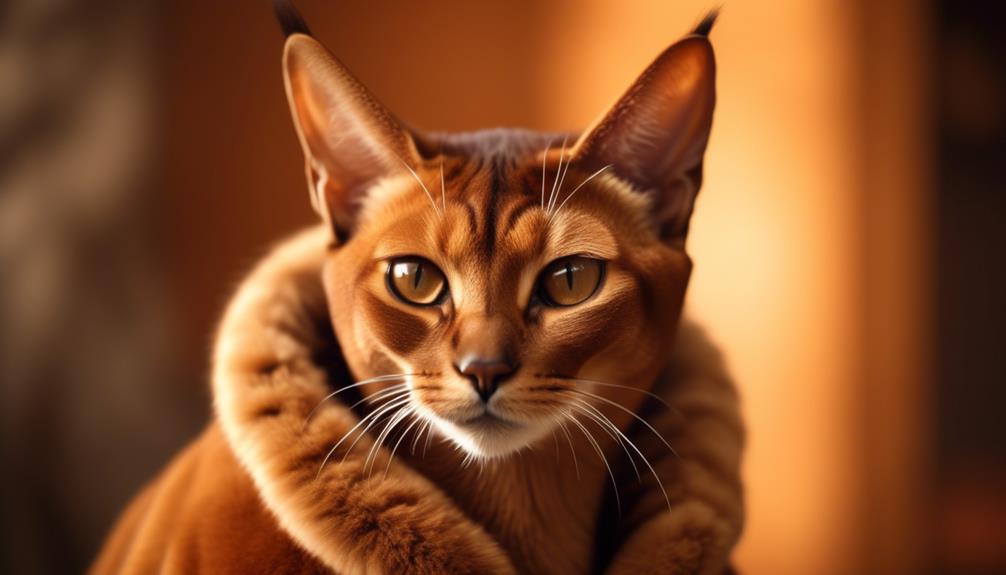
With their short, ticked coat and various colors and patterns, Abyssinians exhibit unique and captivating coat characteristics.
The coat of an Abyssinian is soft, silky, and dense, providing excellent protection against the elements.
These cats have a distinctive ticked pattern, with each hair banded with multiple colors, giving them a shimmering appearance.
Abyssinians’ most common coat colors include ruddy, red, blue, and fawn, although variations like cinnamon, chocolate, and lilac also vary.
In addition to the ticked pattern, Abyssinians can have tabby markings on their face, legs, and tail. This combination of colors and patterns adds to the allure and beauty of this breed.
| Coat Colors | Coat Patterns |
|---|---|
| Ruddy | Ticked |
| Red | Tabby |
| Blue | |
| Fawn |
Historical Significance
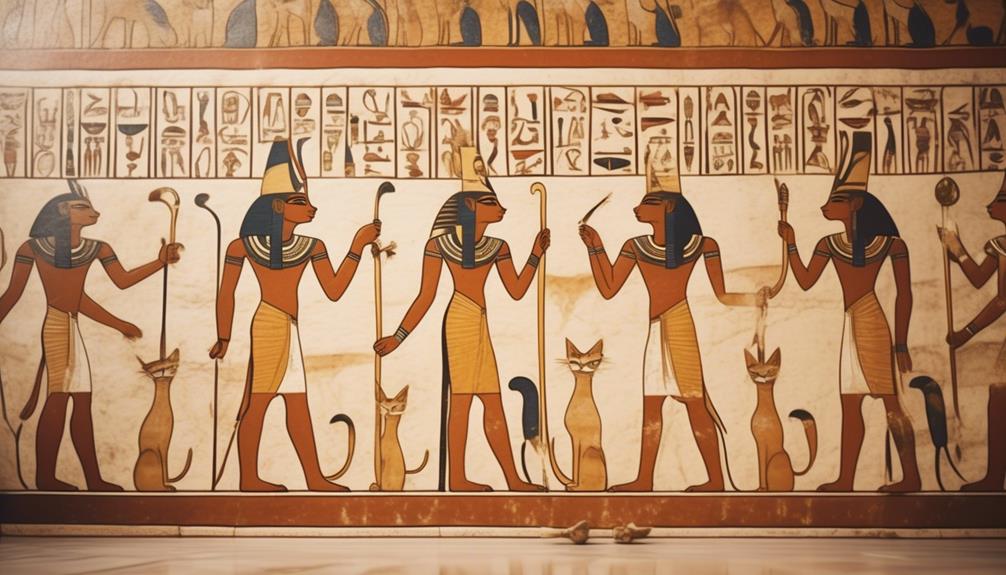
The Abyssinian cat breed has been significant throughout history due to its mysterious origins and captivating characteristics.
Here are three reasons why this breed has left a mark in history:
- Ancient Origins:
The Abyssinian’s exact origins remain unknown, but they are believed to have originated near the coast of the Indian Ocean and Southeast Asia. The breed’s genetic evidence suggests that it may have been brought by British and Dutch traders, further adding to its intriguing history.
- First Mention:
The Abyssinian first appeared at the Crystal Palace Cat Show in 1871, gaining recognition and sparking interest in cat enthusiasts. Since then, it has become a beloved breed worldwide.
- Indian Ocean Connection:
The theory of Indian Ocean origin is supported by a specimen exhibited in the 1830s. This connection to distant lands adds an air of exoticism and allure to the Abyssinian’s historical significance.
The Abyssinian’s enigmatic past and captivating presence continue to make it a breed of great historical importance.
Mysterious Origins
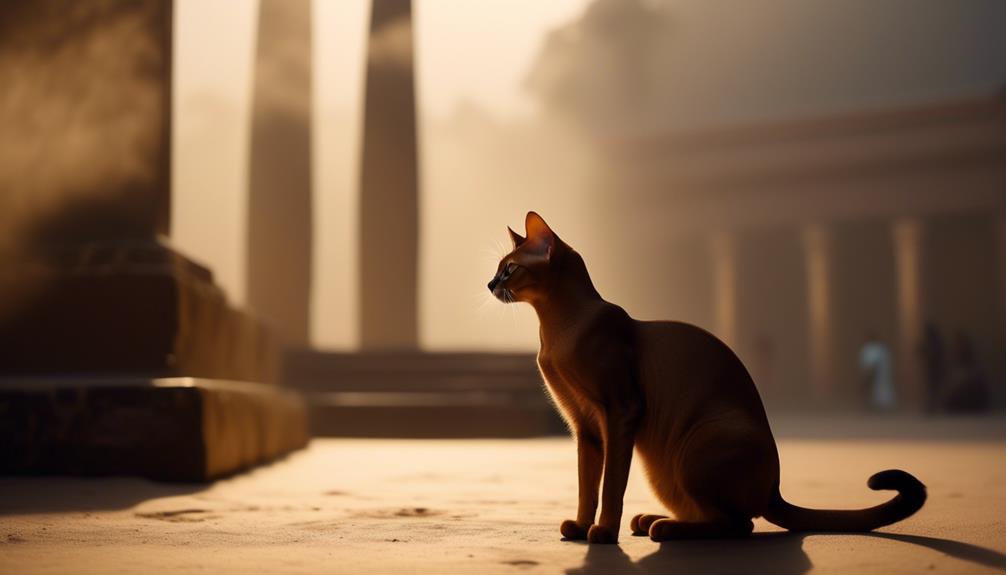
The origins of the Abyssinian cat breed have long remained shrouded in mystery, leaving cat enthusiasts and historians intrigued by its enigmatic past. Despite extensive research, no concrete records exist regarding the breed’s origins.
However, genetic evidence suggests these cats may have come from coastal regions near the Indian Ocean and Southeast Asia.
One theory posits that British and Dutch traders returned these cats from their travels. Additionally, an exhibit in the 1830s supports the theory of Indian Ocean origin.
While the exact details remain elusive, the Abyssinian’s mysterious origins only add to its allure and charm, making it a captivating breed with a captivating past.
Potential Trade Routes

One possible explanation for the origin of the Abyssinian cat breed lies in the exploration and trade routes of British and Dutch traders in the Indian Ocean and Southeast Asia.
These traders, active during the 17th and 18th centuries, traveled extensively and interacted with various cultures and regions.
Here are three key points to consider regarding the potential trade routes that may have influenced the development of the Abyssinian breed:
1) British traders in India: British traders had a significant presence in India during this period, and it is possible that they encountered cats with similar characteristics to the Abyssinian breed. These cats may have been brought back to Britain and further bred to create the breed we know today.
2) Dutch traders in Indonesia: Dutch traders were heavily involved in the trade routes between Europe and Southeast Asia, particularly in Indonesia. It is plausible that they encountered cats in these regions that contributed to the development of the Abyssinian breed.
3) Coastal regions of the Indian Ocean: The Abyssinian breed is believed to have originated from the coastal regions of the Indian Ocean. The trading activities in these areas might have played a role in introducing these cats to other parts of the world.
These potential trade routes provide insight into how the Abyssinian breed could have been influenced by the movement of traders and their interactions with cats in different regions of the Indian Ocean and Southeast Asia.
Importance of Adoption or Reputable Breeders
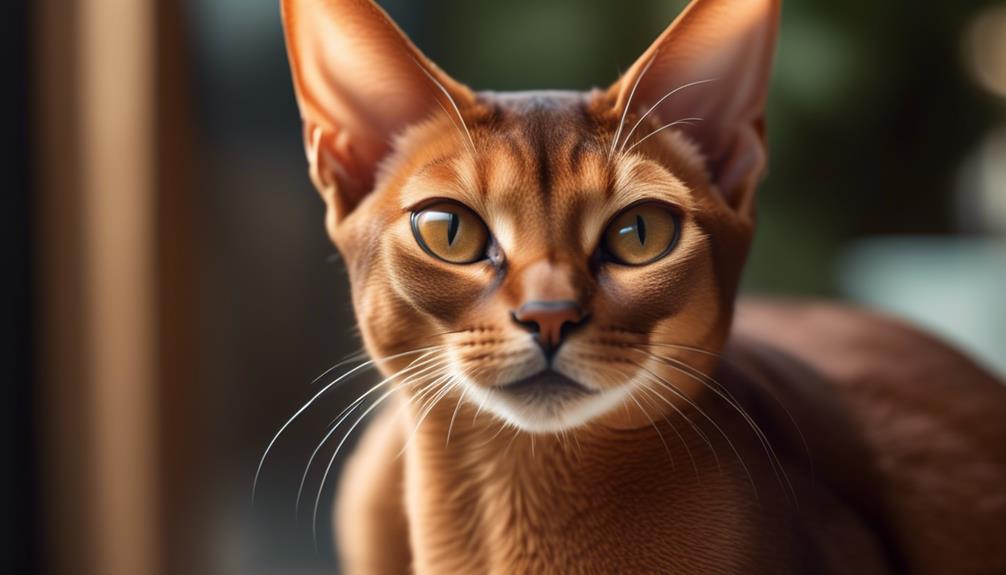
When considering acquiring an Abyssinian cat, it is vital to prioritize adoption from reputable shelters or rescue organizations or choose a reputable breeder.
Adopting a shelter or rescue organization provides a loving home for a needy cat and helps reduce the number of homeless cats.
Reputable shelters and rescue organizations ensure that the cats are properly cared for, vaccinated, and spayed or neutered before adoption. Additionally, they often conduct behavioral assessments to match the cat with the right owner.
If choosing a breeder, it is crucial to research their ethical practices, ensuring that they prioritize the health and temperament of their cats.
Reputable breeders conduct necessary health screenings, provide a nurturing environment, and are transparent about the cat’s lineage and genetic history.
Researching Ethical Practices
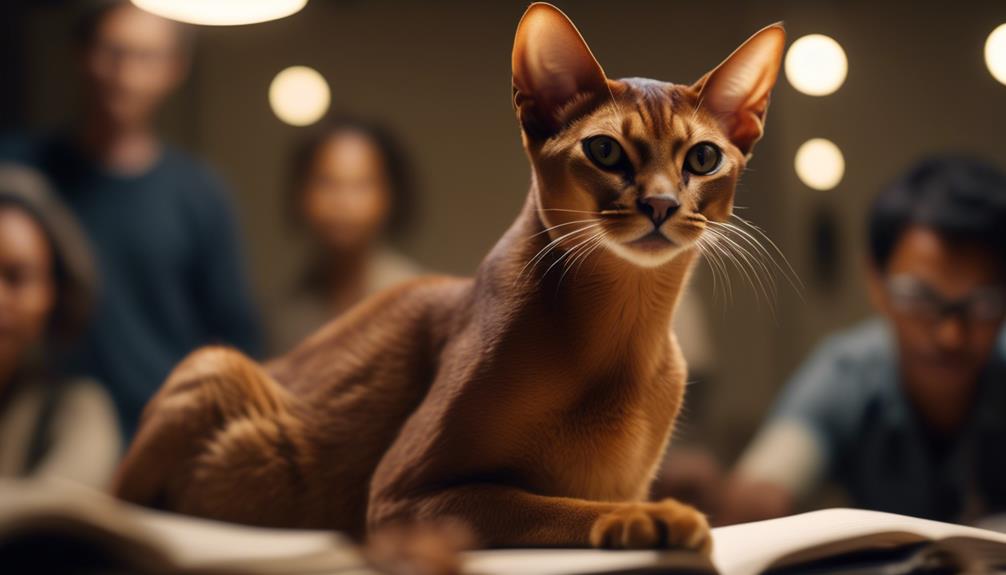
After considering the importance of adopting or choosing a reputable breeder for an Abyssinian cat, it is essential to thoroughly research potential breeders’ ethical practices.
Here are three key factors to consider when researching ethical practices:
- Breeder’s reputation: Look for breeders with a positive reputation within the cat breeding community. Check for online reviews and testimonials from previous buyers to gather insights into their breeding practices and the health and temperament of their cats.
- Breeding environment: A responsible breeder will provide their cats with a clean and nurturing environment. They should allow potential buyers to visit their facilities and meet the cats to assess their well-being.
- Health screenings and guarantees: Ethical breeders prioritize their cats’ health and conduct necessary health screenings, such as genetic testing for common breed-specific conditions. They should also provide health guarantees and be willing to answer any questions regarding the health history of their cats.
Temperament and Exercise Needs
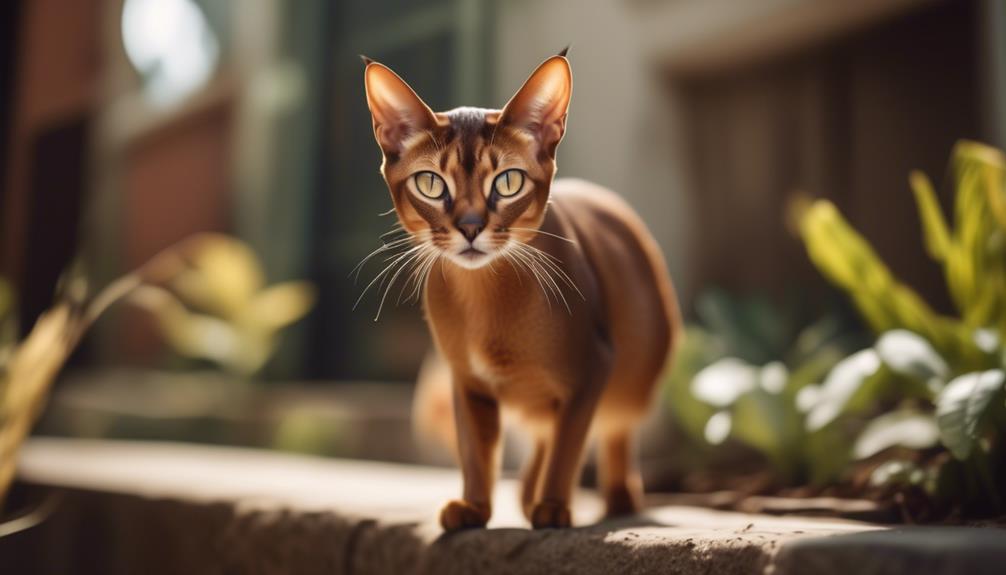
The Abyssinian cat is known for its playful temperament and high exercise needs. These cats are highly active and require plenty of mental and physical stimulation to stay happy and healthy.
They love interactive play, such as chasing toys or playing fetch, and enjoy climbing and exploring their environment.
Providing them with plenty of toys and scratching posts is important to satisfy their instincts. Abyssinians are also known for their affectionate nature and enjoy spending time with their human companions.
They are intelligent and trainable, making them a great choice for owners willing to provide them with the mental and physical stimulation they need.
Regular playtime and exercise are essential to ensure the overall well-being of an Abyssinian cat.
Trainability and Grooming
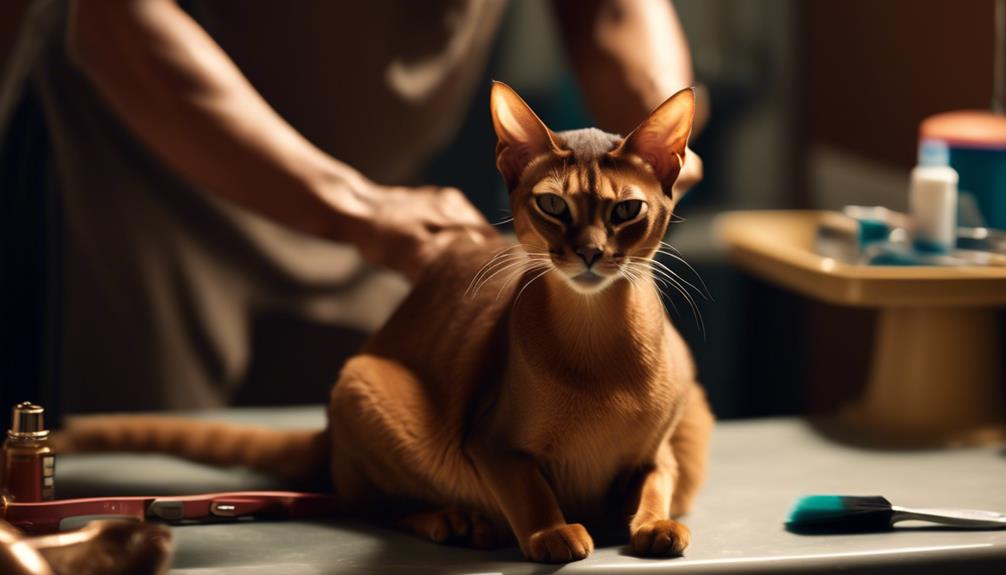
Abyssinian cats are known for their high trainability and low-maintenance grooming needs.
Here are three reasons why these characteristics make them a popular choice for cat owners:
- Intelligent and eager to please: Abyssinians are highly intelligent and can quickly learn tricks and commands. They enjoy interactive play and can be easily motivated with positive reinforcement training methods.
- Minimal grooming requirements: Unlike other cat breeds, Abyssinians have short, fine coats that don’t mat easily. This means they require minimal grooming. Weekly combing to remove loose hair and an occasional bath during shedding seasons are usually sufficient to keep their coats in good condition.
- Independent self-groomers: Abyssinians are known for their self-grooming habits. They have an instinct to keep themselves clean and tidy. This means less work for cat owners regarding grooming and maintaining their cat’s appearance.
Health Conditions to Watch for
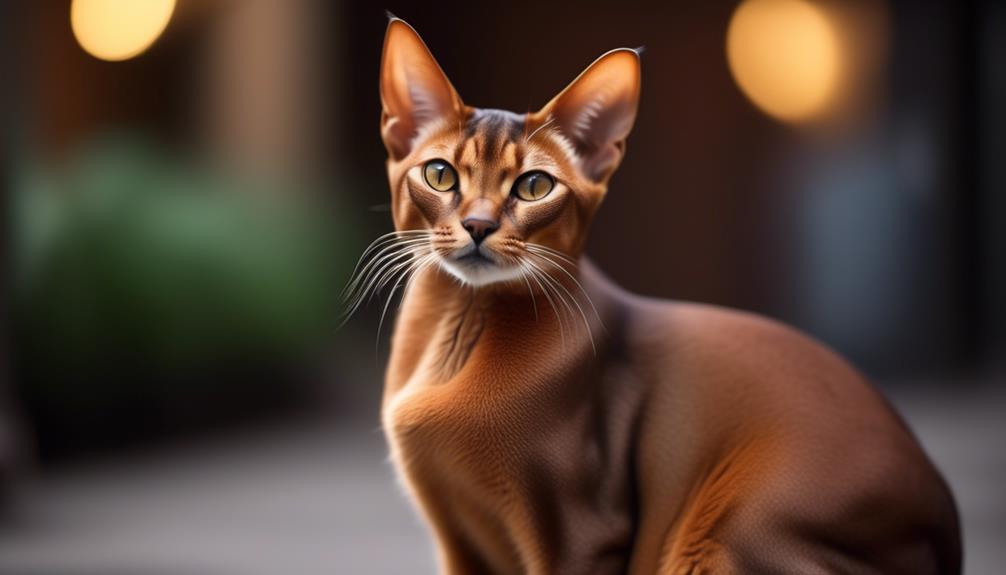
One important aspect to consider when owning an Abyssinian cat is awareness of potential health conditions to watch for.
While Abyssinians are generally a healthy breed, there are a few conditions that they may be prone to.
One such condition is progressive retinal atrophy (PRA), a degenerative eye disease that can lead to blindness. It is important to have regular eye check-ups with a veterinarian to monitor any signs of PRA.
Another condition to watch for is amyloidosis, a disorder in which abnormal proteins build up in the body’s organs, potentially leading to organ failure.
Regular check-ups and monitoring of liver function can help in the early detection of this condition.
Care Tips for Abyssinian Cats
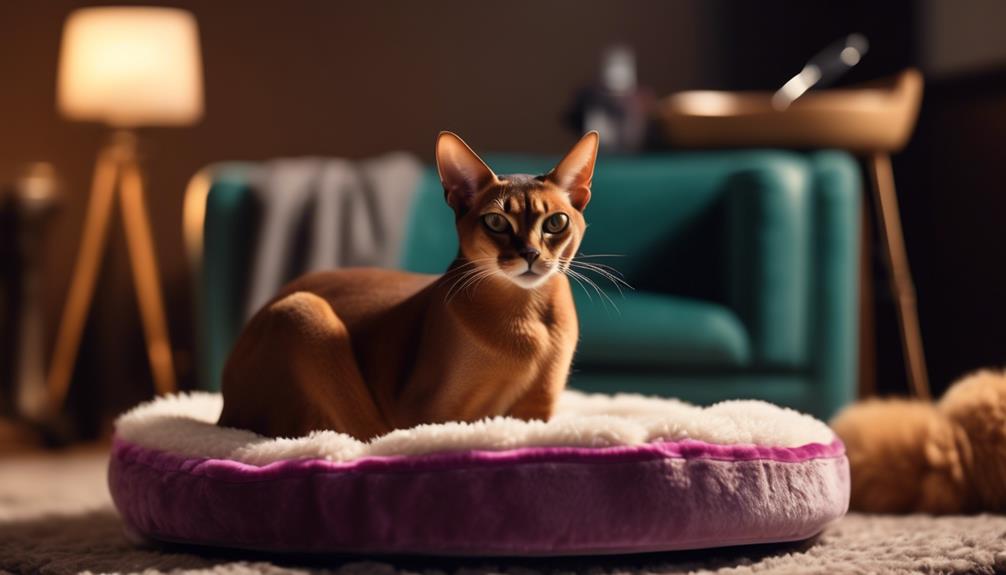
When it comes to ensuring the well-being of Abyssinian cats, proper care is essential for maintaining their health and happiness.
Here are three care tips to keep in mind:
- Provide plenty of exercise: Abyssinians are known for their high energy levels, so it’s important to provide them with opportunities for physical activity. Engage them in interactive play sessions and provide toys to stimulate their natural hunting instincts.
- Ensure mental stimulation: These intelligent cats need mental stimulation to prevent boredom. Consider puzzle toys, treat-dispensing toys, or even training sessions to keep their minds engaged. This will help prevent destructive behavior and promote overall well-being.
- Maintain a balanced diet: Feed your Abyssinian a high-quality diet that meets their nutritional needs. Consult with your veterinarian to determine the appropriate portion sizes and feeding schedule. Remember to provide fresh water at all times.
Frequently Asked Questions
Are Abyssinian Cats Hypoallergenic?
Abyssinian cats are not hypoallergenic. While they have short, fine coats that require minimal grooming, they still produce allergenic proteins in their saliva and skin, which can trigger allergies in susceptible individuals.
What Is the Average Cost of an Abyssinian Cat From a Reputable Breeder?
The average cost of an Abyssinian cat from a reputable breeder can vary depending on location, pedigree, and breeder reputation. It is recommended to research and contact breeders directly for specific pricing information.
Can Abyssinian Cats Be Left Alone for Long Periods?
Like any other breed, Abyssinian cats may experience separation anxiety if left alone for long periods. It is important to provide them with mental stimulation, toys, and a comfortable environment to minimize stress and potential behavior problems.
Are Abyssinian Cats Good With Children and Other Pets?
Abyssinian cats are generally good with children and other pets due to their playful and affectionate temperament. However, it is important to introduce them gradually and supervise interactions to ensure a positive and harmonious relationship.
Do Abyssinian Cats Require a Special Diet or Feeding Routine?
Abyssinian cats do not require a special diet or feeding routine. However, it is important to provide them with a balanced and nutritious diet that meets their specific needs. Consult with a veterinarian for dietary recommendations.
Conclusion
In conclusion, the Abyssinian cat breed is a unique and captivating feline with a rich history and distinctive characteristics.
With its stunning coat, playful temperament, and high exercise needs, Abyssinians make wonderful companions for cat enthusiasts.
Cat owners can provide the best care for these remarkable cats by understanding their origins, temperament, and care requirements.
Whether considering adoption or simply intrigued by this breed, the Abyssinian cat is truly a fascinating and enigmatic companion.




